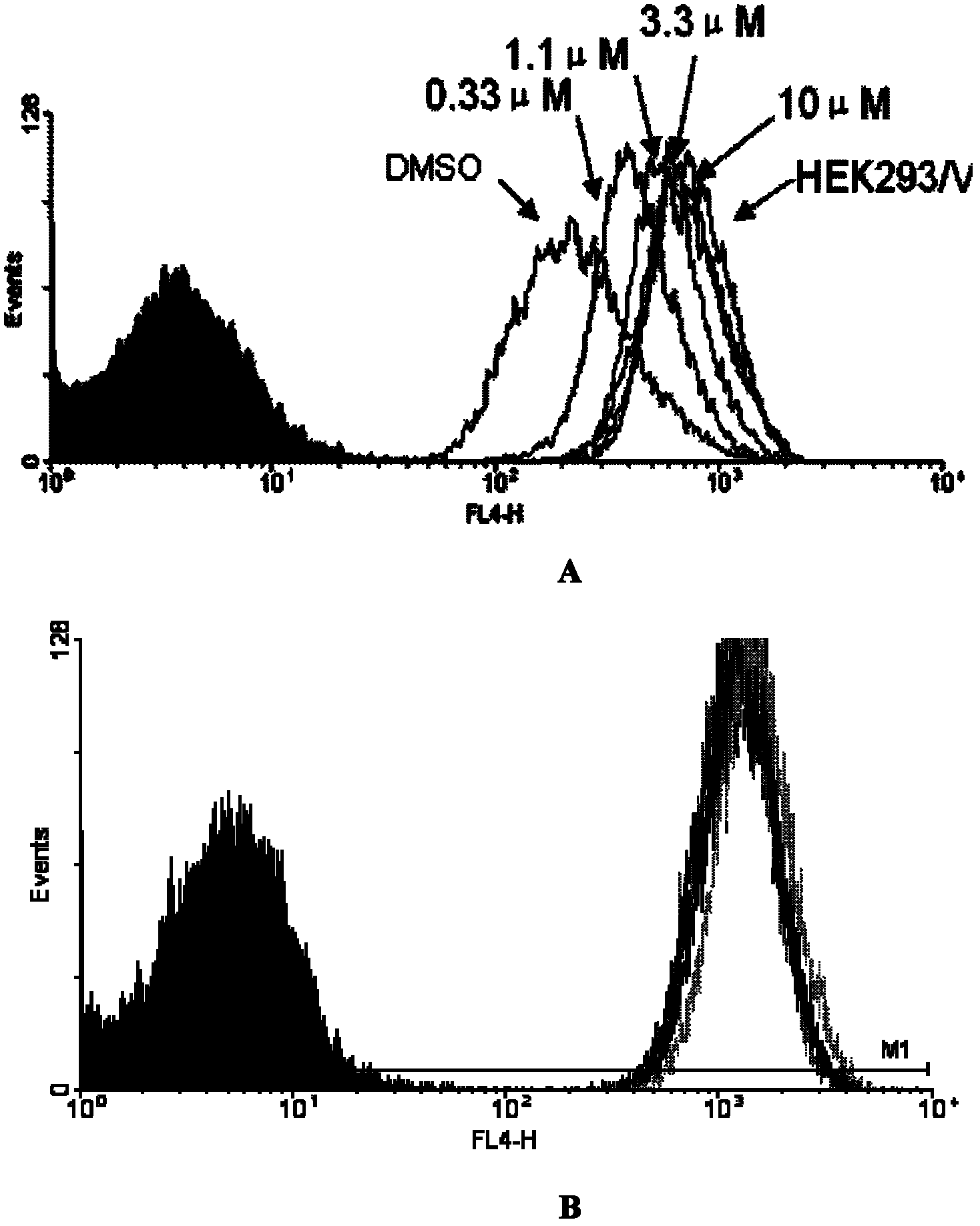Application of sorafenib in the preparation of drugs for reversing tumor multidrug resistance
A multi-drug resistance and drug resistance technology, which can be used in anti-tumor drugs, drug combinations, active ingredients of heterocyclic compounds, etc. Significant degradative effect
- Summary
- Abstract
- Description
- Claims
- Application Information
AI Technical Summary
Problems solved by technology
Method used
Image
Examples
Embodiment 1
[0034] Example 1 Effect of sorafenib on the accumulation of BCRP substrate mitoxantrone in BCRP highly expressed drug-resistant cells
[0035] Harvest the resistant strain HEK293 / BCRP with high expression of BCRP and the parental HEK293 / VEC respectively, add BCRP substrate fluorescent dye MX in the presence or absence of sorafenib (sorafenib concentration is 2.5 μM), 37°C After incubation for one hour, FACS was used to detect the change of fluorescence intensity in the cells. Reversal factor = GMean of treatment group / GMean of DMSO group.
[0036] The results showed that sorafenib could significantly increase the accumulation of mitoxantrone in HEK293 / BCRP in a dose-dependent manner, but had no effect on parental cells ( Figure 1-2 ). However, taking a similar method, sorafenib has no similar effect in K562 / A02 cells with high expression of Pgp. This indicated that Sorafenib could specifically block the efflux of BCRP to its substrate.
Embodiment 2
[0037] Example 2 Effect of Sorafenib on the expression level of BCRP in BCRP highly expressed drug-resistant cells
[0038] Sorafenib was stimulated at 0.625 μM, 1.25 μM, 2.5 μM for 72 h or 2.5 μM for 24 h, 48 h, and 72 h on HEK293 / BCRP cells, and Weston Blot technique was used to detect the expression of BCRP.
[0039] The results showed that Sorafenib could significantly, dose- and time-dependently reduce the protein expression level of BCRP ( image 3 ). Taking a similar approach, it was found that Sorafenib could not cause the degradation of Pgp. At the same time, it was detected that the selected reversal concentration had no effect on the phosphorylation levels of AKT and ERK.
Embodiment 3
[0040] Example 3 Sorafenib specifically reverses BCRP-mediated multidrug resistance in vitro
[0041] HEK293 / BCRP cells highly expressing BCRP were suspended in 10% FBS / DMEM and seeded in 96-well microplates (40000 cells / 160 μl / well), and cultured at 5% CO2 and 37°C for 24 hours. Add 20 μl of Sorafenib solution to the final concentration of 0.625 μM, 1.25 μM, 2.5 μM (IC 10 non-toxic dose), 5% CO2, 37 ° C incubation for 2h, add mitoxantrone solution 20μl to a final concentration of 100nM (IC 10 The non-toxic dose within 100 g), the cell viability was determined by the MTS method after 72 hours of culture.
[0042] The results showed that the survival rate of drug-resistant cells decreased significantly after the non-toxic dose of sorafenib and mitoxantrone acted together, and the same experiment did not have this effect on sensitive cells HEK293 / VEC, indicating that sorafenib can specifically Reversal of HEK293 / BCRP resistance to mitoxantrone ( Figure 4 ). Using a similar me...
PUM
 Login to View More
Login to View More Abstract
Description
Claims
Application Information
 Login to View More
Login to View More - R&D
- Intellectual Property
- Life Sciences
- Materials
- Tech Scout
- Unparalleled Data Quality
- Higher Quality Content
- 60% Fewer Hallucinations
Browse by: Latest US Patents, China's latest patents, Technical Efficacy Thesaurus, Application Domain, Technology Topic, Popular Technical Reports.
© 2025 PatSnap. All rights reserved.Legal|Privacy policy|Modern Slavery Act Transparency Statement|Sitemap|About US| Contact US: help@patsnap.com



